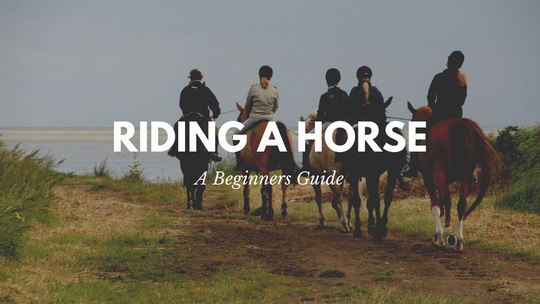
Are You & Your Horse Ready For Bitting Advice? The Steps You Need To Consider First
Equestrian Advice & Guides All Disciplines
Build your business profile for FREE and expose your services to thousands of potential clients!
Create my profile now!
At times frustrating, at times highly rewarding – teaching a beginner the joys of riding for the first time is a challenging job. Just remember how delightful your first introduction was learning to ride. There’s nothing more enjoyable than seeing a beginner’s eyes light up with joy whilst riding. However, you’ll need to remember that it’s not an easy task, training someone to ride, in fact it's almost as hard as learning.
Sometimes it’s hard to judge the right amount of instruction needed for a beginner looking to learn the basics of horse riding. So, here at Horsemart, we put together this cracking guide to help you out. We have included plenty of useful tips, advice and snippets of information to help you help others with ease.
If you want your apprentice to be as skilled as they possibly can in all aspects of riding, you need to do some work before they get on the saddle - it’s not all about just getting on and riding!
Making sure they can effectively look after a horse is vital before riding, as if they don’t understand how the animal operates, they’re not ready to ride. Not only this, but it’s a great way to build a relationship with the horse beforehand which could be a great help when getting the horse to listen and respond to your demands. Things like grooming, feeding, leading and tying your horse need to be done successfully in order to be ready to learn. Check out our ultimate horse health guide for a really in depth look at how to care for your horse.
Before a lesson begins, encourage the beginner rider to assist you with leading the horse out into the paddock. This will help the rider and horse build an affinity before the lesson has even begun. Introducing techniques such as catching and haltering at an early stage will help the rider gain an insight into just how important leadership is in commanding the horse’s respect and attention. Get the student standing in the correct position with the lead rope and guide them towards the paddock, only intervening if the horse shows any reluctance to obey.
A little grooming out in the paddock may help to take some of the tension out of proceedings. While a beginner will naturally be excited to start learning, they may also have some nerves about how the horse will react to them. A short grooming session will not only allow you to educate a beginner rider on the importance of the grooming process – it’ll also calm both the nerves of the student before they mount and place the horse in a relaxed mood that will hopefully set the tone for the lesson itself.
When beginners start, it’s so important that they have the right clothing and footwear for them, so they don’t have to worry about comfort or product performance; they can just focus on riding.
A good pair of riding boots is essential, as well as a comfortable pair of riding tights or jodhpurs and a perfectly fitted jumper or shirt. Once these are sorted, the rider can really focus on the job at hand. Equine superstore have the best selection of riding gear available.
Teaching your apprentice how to saddle up the horse is a really good habit to get into early on, as it’s all about practice and they won’t have someone there to help them forever. Making sure your horse is correctly saddled is vital for the safety of both the rider and the animal, so take care with this.
You need to make sure that the horse is tied first, so that you can saddle up with maximum security and prevent any movement. Then make sure your saddle pad is correctly positioned neatly and securely, ready for the saddle itself. Start by placing it higher than you want, over the withers, then pull it back into place where your rider will sit. This way, the horses hair will be flat under the pad. After this, make sure it’s places flat and smooth, with no scruffy folds or wrinkles.
Now you can Lift the saddle onto your horse. Make sure that the stirrups aren’t hangin down when you put the saddle on, as they’re quite heavy duty and they could cause harm if they hit you or the horse in the process. When you actually lift the saddle, obviously make sure it’s high enough to avoid collision or knock the pad. And when you put it down, place it gently - don’t slam it onto the horses back. That could surprise your horse and cause them to spook.
Then you can check both sides of the saddle to ensure that they are placed correctly, without disruption to your horse, their hair or the saddle pad. Then you can let the stirrups hang and begin to fasten the saddle. Grab the girth or cinch at one end and fasten, buckle or tie it, loosely at first. This way you can slowly tighten the girth to prevent any discomfort or surprise for the horse. Do it in stages, as you can get a better indication as to what’s right for the horse. The idea is to only fasten it tight enough for the saddle to be secure; any tighter is just unnecessary discomfort for your horse.
The horse is ready, and your beginner should be too, so now they can get on. This can be harder than expected for the first couple of attempts, so always have someone to help you. Most people will be able to mount right from the floor, but some smaller or less able riders might need a mounting block to aid them.
Standing beside the horse with your dominant side closest, grab both reins and hold the far side rein a little tighter to prevent any instability for you. Most people with face slightly forward when mounting to give greater momentum on the way up, but whichever way you choose, make sure your foot is securely in the stirrup to avoid falling. Next, hold the saddles cantle and let your free leg balance you, ready to push off. When you push off don’t pull up with your arms, they should only be providing support. If you push hard enough with your leg, you should find you make it up with ease.
Swing your leg over your horse and lower carefully into the saddle. If you sit into your horse hard, you’ll spook them.
Remember, teaching a beginner means teaching the basics. Early training needs to be kept simple, concise and fun. You want to encourage inexperienced riders to develop a real appreciation for the activity, not put them off at the first hurdle. Cast your mind back to the mix of anticipation and fear that you felt on your first lesson as the trainer offered advice; the most important talent for any trainer teaching a novice is the ability to make the beginner rider feel at ease as they develop their skills. Yes, it can be frustrating if constant instruction is needed, but it’s unlikely the rider will want to continue listening to your advice if they feel under unmerited pressure.
The key skills you’ll need to transmit to the beginner rider are the importance of mastering balance on the saddle, the art of riding itself (shifting of gaits etc), and most crucially, the significance of instilling good discipline and exercising control over the horse. You’ll also need to discuss with the beginner rider the horse’s body structure and the riding positions needed to ensure a horse feels no pain when you head out riding.
Any beginner horse riding lesson needs to include a few simple walking and stopping exercises. Explain the concept of spooking to the rider so they realise the importance of staying calm and not frightening the horse should they feel a little nervous and unsteady at first. Demonstrate basic techniques such as holding the reins correctly, the pressure needed to squeeze the horse’s legs to spur movement, stopping, and how to turn from side to side.
The first lesson needs to be focused on balance, so don’t introduce more advanced techniques until the rider feels completely comfortable and in control moving around on the horse.
Finally, once the lesson has finished, advise your fledgling rider on the essential steps they’ll need to take once the horse has returned to the stable. Teach them how to warm down the horse, dismount safely, and once down from the horse, how to remove and store essential tack. Get the rider to check the horse’s condition, carrying out grooming as necessary. This will help a novice to appreciate that equine maintenance is just as important as the horse riding process itself.
Hopefully, your beginner is keen to learn again, and you can repeat the process until they feel they’ve mastered the basics. Progression will be slow, but eventually you can move your rider up to trotting and cantering. You may want to take a step back occasionally to watch them perform these steps unaided, then you can give them feedback for what improvements they should make. The more confident they get, the less help they will need. Eventually, they might even be able to come for a ride with you!
Check out more of our horse guides and helpful tips right here.

